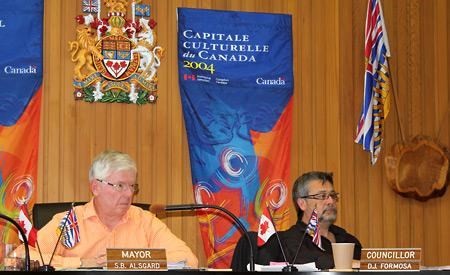After two special council meetings and close to five hours of discussion, City of Powell River council approved a phased consolidated treatment option as the preferred choice for liquid waste management, subject to a long list of conditions.
Councillors debated the “phased consolidated treatment option,” a city staff recommendation, during a special council meeting held Thursday afternoon, June 23 and again on Monday, June 27. The option combines joint treatment, a proposal to treat the city’s sewage at Catalyst Paper Corporation’s Powell River mill, with a stand-alone consolidated plant. These two options have been the topic of public consultation and discussion at both the liquid waste management plan (LWMP) joint local-technical advisory (JAC) and steering committees. However, the combination of the two into one option officially appeared in a report from Richard Stogre, manager of engineering services, dated June 16.
At both special council meetings, Mayor Stewart Alsgard started the proceedings by reading out a number of letters. At Thursday’s meeting, 20 letters were included on the agenda, 18 in support of joint treatment and two opposed. Alsgard read another 24 letters, 22 in favour of joint treatment and two opposed. At Monday’s meeting, Alsgard again read all the letters, including eight on the agenda and 23 new ones. Of those, nine were in favour of co-treatment while 22 opposed it. Additionally, Alsgard read a six-page letter from George Orchiston, a former Catalyst employee, outlining his extensive research into the impact combining the city’s sewage with the company’s effluent will have on the health and safety of workers.
On Thursday, council had postponed voting on a motion and asked staff to find out if it needed to take the phased consolidated option back to JAC before voting on it. On Monday, Alsgard read an email from John Braman, the ministry of environment’s regional manager, advising council of the ministry’s position. The short answer, Braman wrote, is it is up to council to decide whether it has enough information for an informed decision.
After the letters were read, council continued the debate, which began at Thursday’s meeting, on a motion to approve the phased consolidated treatment option. Councillor Dave Formosa said he would be voting against the motion, because he thought a number of issues should be addressed.
When the vote was taken on Monday, Councillors Jim Palm and Chris McNaughton voted in favour of the motion, while Formosa, Alsgard, and councillors Debbie Dee, Maggie Hathaway and Aaron Pinch voted in opposition to it.
When the motion was defeated, Formosa brought forward another motion to approve phased consolidation, subject to: the city receiving a grant from UBCM’s (Union of BC Municipalities) Innovations program, which would provide funds for joint treatment infrastructure as well as for developing plans for a consolidated plant; purchasing land from PRSC Limited Partnership for a consolidated plant; pumping sewage from a pre-treatment facility to the mill’s station A and C if technically possible and financially beneficial to the city; a 10-year service agreement with Catalyst at $500,000 a year; tests of fecal coliforms and other pathogens in the city’s sewage; and further tests of the combination of city sewage with the mill’s effluent to ensure components in the city’s sewage wouldn’t kill off the bugs in the mill’s system. The tests would determine if the city was required to disinfect its sewage before it entered the mill’s system.
Hathaway alone voted in opposition to the motion, saying she believed the option should be referred back to the JAC before council voted on it.



